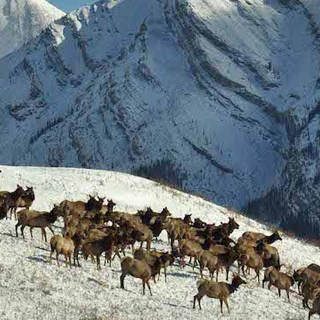Partial Migration

Migration is a behavioral strategy across taxa to maximize fitness in seasonal environments by allowing individuals to adapt to spatiotemporal variation in resource abundance. Animals also migrate to escape from predation at local to continental scales. Migration is one of nature’s most iconic processes. However, migration is also a fundamental ecological conundrum. If migration is such a good strategy, why doesn’t everyone do it? Across taxa and species, many migratory populations are comprised of both migratory and resident individuals — known as partial migration.
An interest in the ecology of partial migration is driven, in part, because of worldwide declines in migration across taxa driven by anthropogenic habitat fragmentation/loss and climate change. While our understanding of partial migration is growing, for one key taxonomic group, large herbivores, partial migration remains a mystery prompted by the lack of long-term individually based studies on these long-lived species. The partially migratory Ya Ha Tinda elk population are the perfect population to study to better understand partial migration.
We initiated our study in 2002 to understand changes in migration relative to historic studies in the 1980s; thus, our focus from the beginning has been the demography of migration. We developed pioneering methods to combine ground plant monitoring with remote sensing to build dynamic landscape models of forage quality. Initially, we assumed a fixed migration strategy in the elk of Ya Ha Tinda in part because of the low switching between migration strategies observed in our first three years of study. After 12 years of monitoring, however, we have now observed a much higher degree of switching between strategies than previously reported in scientific literature for large herbivores.
On average, 16% of the elk studied switched migration strategies every year. An elk in this population lives approximately 12 years, which means they might switch migratory strategies twice per lifetime.
The core of our research is the long-term monitoring of individually marked adult female elk, forage and predation risk. We focus on female elk because of their crucial importance to mammalian population dynamics. During the period 2002 through 2014, we tracked the fates of 268 unique, radio-collared adult female elk (average of 86 females/year monitored for an average of four years each). We've also collected data on other key demographic, migratory and ecological variables.
We install GPS collars on female elk and radiotag the neonatal elk calves in addition to collecting other key measurements of individuals. We have captured and put GPS collars on wolves in the study system but more recently, working with Parks Canada, we've developed and implemented a network of more than 200 remote wildlife cameras to monitor spatiotemporal occurence and relative abundance of multiple carnivore species.
We use these data to estimate adult female survival and cause-specific mortality. We work collaboratively with partner agencies to estimate population size every winter. We estimate reproductive traits in addition to pregnancy and population-level spring recruitment.
Our research also looks into the effects of habitat on the Ya Ha Tinda population. Elk diet is mostly composed of grass and a reduction of available forage impacts the elk population. We continue to collect, process and manage spatial and in-situ plant vegetation plot data to track long-term variation in primary productivity of elk forage plants on the Ya Ha Tinda study area. We also collect remotely sensed vegetation indices for the study area from the MODIS satellite platform.
Looking forward
We plan to continue the long-term monitoring of elk at Ya Ha Tinda for the next ten years. We'll continue our approach by radio collaring approximately 20 new female elk per year and monitor migration, resource selection and demography. We will also continue to monitor the migratory status of individuals over time. This is the most crucial data to help us better understand the ecology of partial migration.
